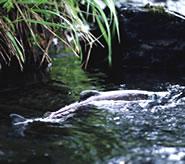 Salmon spawn tree growth.© Photodisc
Salmon spawn tree growth.© PhotodiscTrees depend on salmon and salmon depend on trees, say US researchers. Fish corpses fertilize riverside vegetation and the woody debris improves salmon breeding success.
This suggests that forest and salmon management should be integrated. What's more, other threats to salmon populations, such as pollution or overfishing, may affect forests.
Salmon populations are declining in the Atlantic and the Pacific. In the past century salmon numbers in California, Oregon and Washington, for example, have fallen by about 90%. The geographical scale of the trends has led researchers to assume that the cause lies in the sea, and is perhaps related to climate.
"But numbers are now so low that factors within individual rivers are starting to play a part - they can be the straw that breaks the camel's back," comments Stewart Welton of the Centre for Ecology and Hydrology, in Dorset, UK.
Unfortunately "bank maintenance is a long-term solution, and managers are often looking for a short-term solution," he adds.
Riverside vegetation gets just under a quarter of its nitrogen - the nutrient that most commonly limits plant growth - from salmon, Robert Naiman, of the University of Washington, Seattle and his student James Helfield have found1.
Naiman and Helfield have been studying pacific salmon (Onchorhyncus spp.) in Alaskan rivers. They exploited chemical differences between the nitrogen in marine and freshwater environments to trace the origin of nutrients in forests bordering the streams.
Bank on it
Migrating salmon are a conveyor belt for nutrients. Pacific salmon move nitrogen and phosphorus upstream from the Pacific Ocean to the Kadashan and Indian rivers in southeast Alaska. Here the fish spawn, die, and release their nitrogen. Young fish travel downstream, fatten in the sea, and repeat the process when they are mature enough to reproduce.
Trees on the banks of salmon-stocked rivers grow more than three times faster than their counterparts alongside a salmon-free river, say the Seattle researchers.
Side-by-side with salmon, Sitka spruce (Picea sitchensis), for example, take 86 years, rather than their usual 300 to reach 50 cm thick. One might even infer past salmon populations from the nitrogen in tree rings, Naiman believes.
Salmon, in turn, need big trees. They clean and shade the water, helping eggs to survive. And strong currents cannot shift their heavy debris, leaving small fish somewhere to hide.
Studies of fish-eating animals had shown that salmon transport marine nitrogen upstream, says freshwater ecologist Alan Hildrew, of Queen Mary and Westfield College, London, UK. Its effect on trees is another piece of the picture.
But, he adds, from a study of only two rivers it is difficult to know whether nutrients from salmon make the land around the river more fertile, or whether more fertile rivers attract salmon. "There might be some intrinsic difference between sites that have salmon and sites that don't," he points out.
-
References
